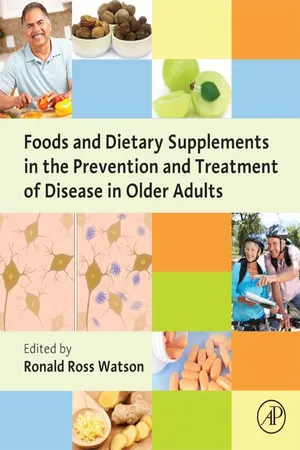
Foods and Dietary Supplements in the Prevention and Treatment of Disease in Older Adults
- 398 pages
- English
- ePUB (mobile friendly)
- Available on iOS & Android
Foods and Dietary Supplements in the Prevention and Treatment of Disease in Older Adults
About this book
Foods and Dietary Supplements in the Prevention and Treatment of Disease in Older Adults focuses on the ways in which food and dietary supplements affect the major health problems of aging adults. Researchers in nutrition, diet, epidemiology, and aging studies, as well as healthcare providers who work with elderly patients will use this comprehensive resource as a tool in their long-term goal of preventing and treating chronic disease within the elderly.This book brings together a broad range of experts working on the different aspects of foods and dietary supplements (vitamins, herbs, plant extracts, etc.) in health promotion and disease prevention. They have contributed chapters which define a range of ways in which foods, nutriceuticals, and dietary supplements prevent disease and promote health in older adults. They begin by reviewing the medicinal role of foods, herbal, and dietary supplements in health promotion in older adults, as well as some of the most commonly used supplements in elder "self-medication." They review the most recent studies of how foods, herbal, and dietary supplements are effective in the prevention and treatment of cancer, cardiovascular disease, diabetes, and other obesity associated diseases in older adults. Then they consider alcohol, other drugs, and plant based drugs of abuse which can adversely affect the health of older adults. Lastly, they consider foods and dietary supplements in gene regulation in older adults.- Investigates the important nutritional requirements of the aging population in health and in relation to various acute and chronic diseases- Explores the nutritional effects of botanical extracts and components that can have important health promotion benefits, and risks, to ensure safe consumption- Reviews studies of common diseases within the aging population including cancer, cardiovascular, metabolic, and infectious diseases that can alter the intake of foods, supplements, and/or requirements for various nutrients- Investigates the mechanisms of action of components of foods and dietary supplements, in particular gene activation and epigenetics
Frequently asked questions
- Essential is ideal for learners and professionals who enjoy exploring a wide range of subjects. Access the Essential Library with 800,000+ trusted titles and best-sellers across business, personal growth, and the humanities. Includes unlimited reading time and Standard Read Aloud voice.
- Complete: Perfect for advanced learners and researchers needing full, unrestricted access. Unlock 1.4M+ books across hundreds of subjects, including academic and specialized titles. The Complete Plan also includes advanced features like Premium Read Aloud and Research Assistant.
Please note we cannot support devices running on iOS 13 and Android 7 or earlier. Learn more about using the app.
Information
A Traditional Elder’s Anti-Aging Cornucopia of North American Plants
Keywords
1.1 Introduction
1.2 Indian Breadroot (Pediomelum esculentum (Pursh) Rydb. formerly Psoralea esculenta Pursh)
Table of contents
- Cover image
- Title page
- Table of Contents
- Copyright
- List of Contributors
- Preface
- Acknowledgments
- Part I: Non-Nutritional Components in Diet and Supplements, Nutraceuticals and their Role in Health Promotion in the Mature Adult
- Part II: Nutraceuticals in Chronic Disease and Cancer Therapy in Seniors
- Part III: Nutritional Approaches to Therapy in Clinical Medicine in Old Age
- Part IV: Food and Supplements in Chronic Heart Diseases, Obesity, and Stroke
- Index